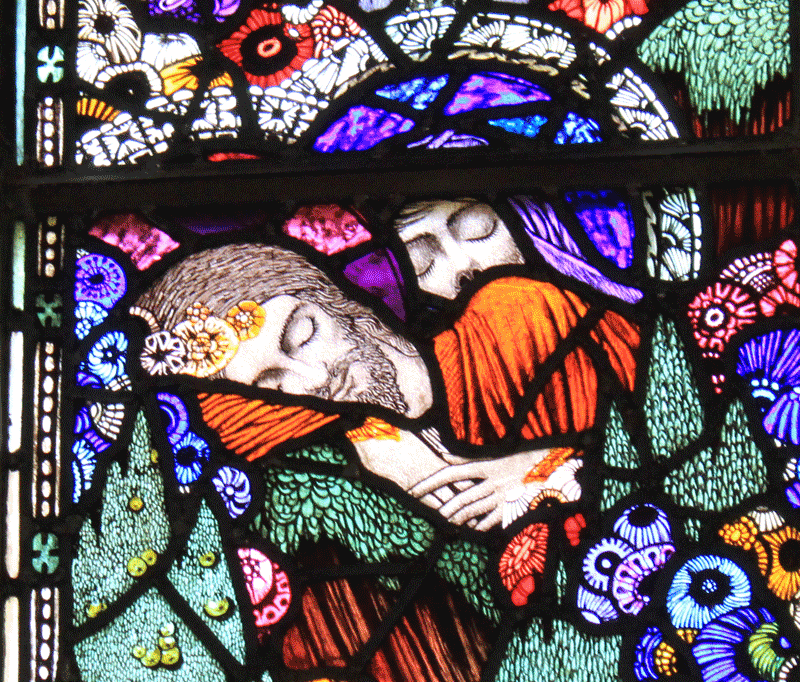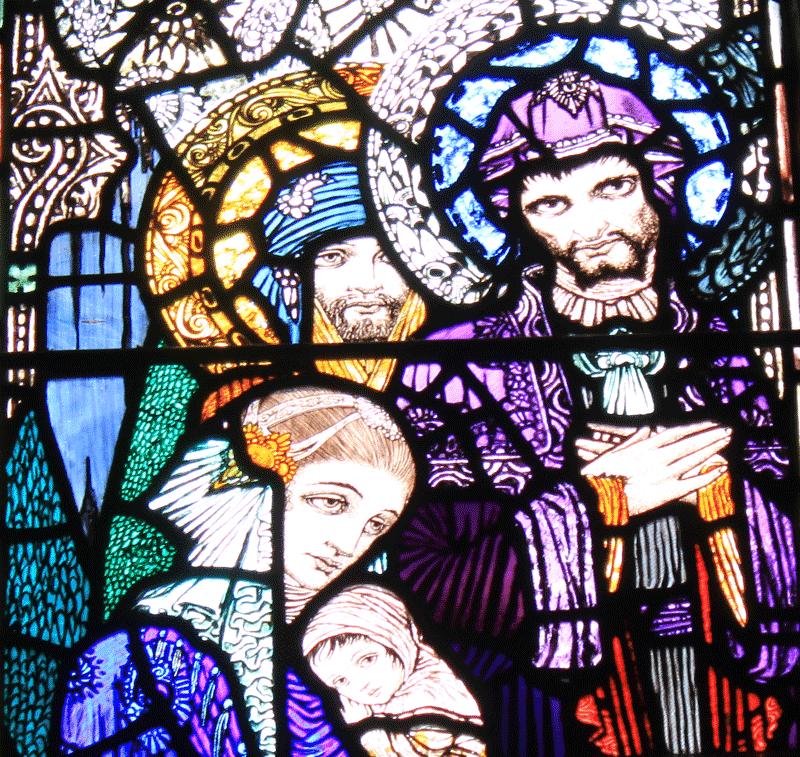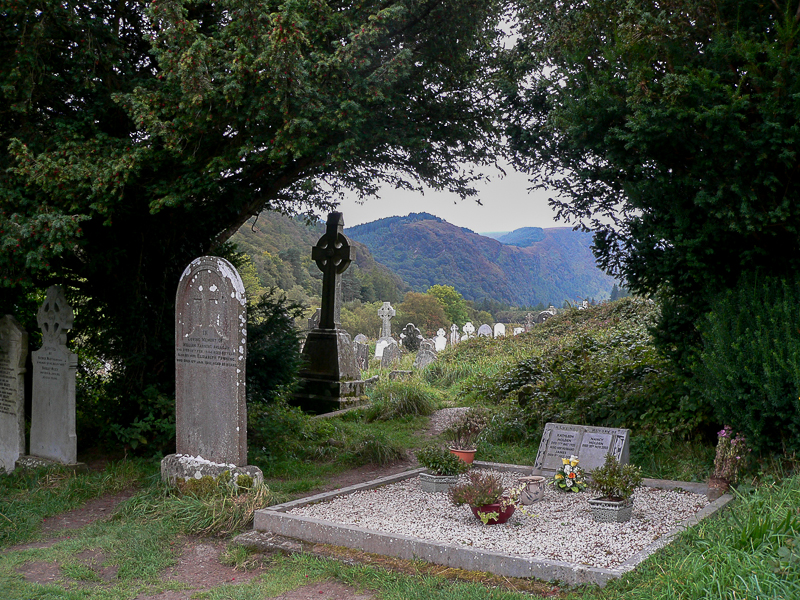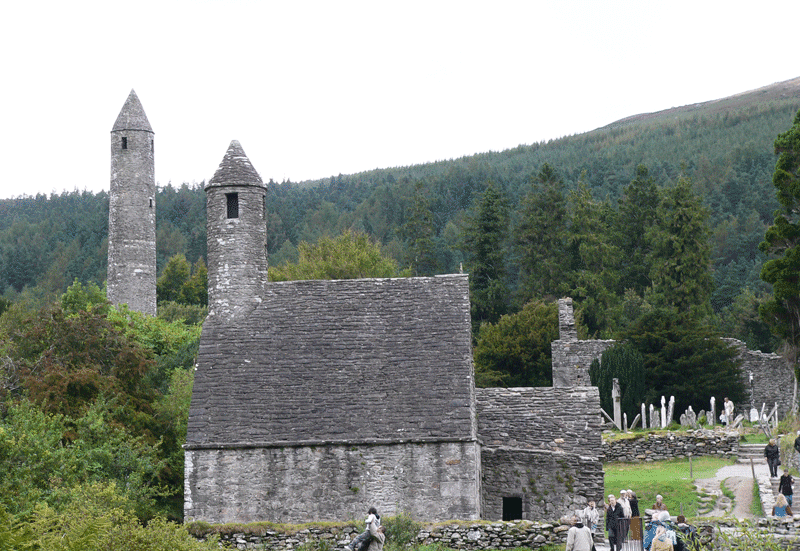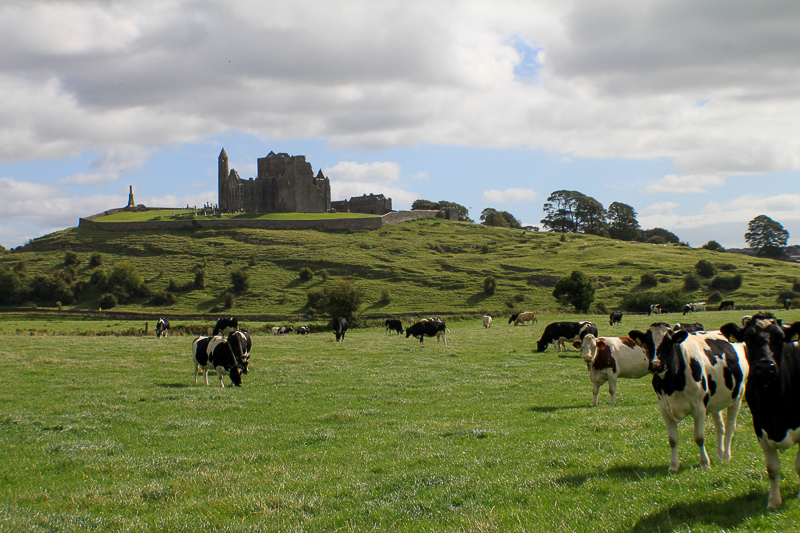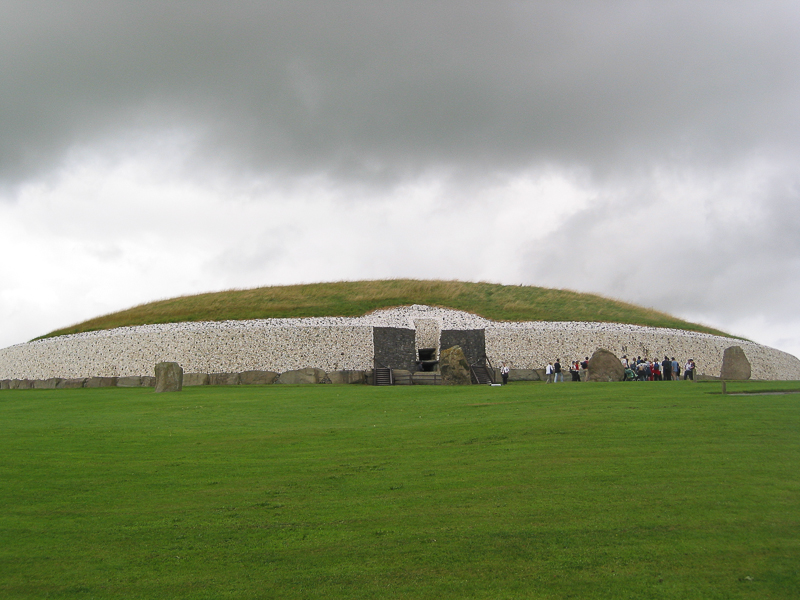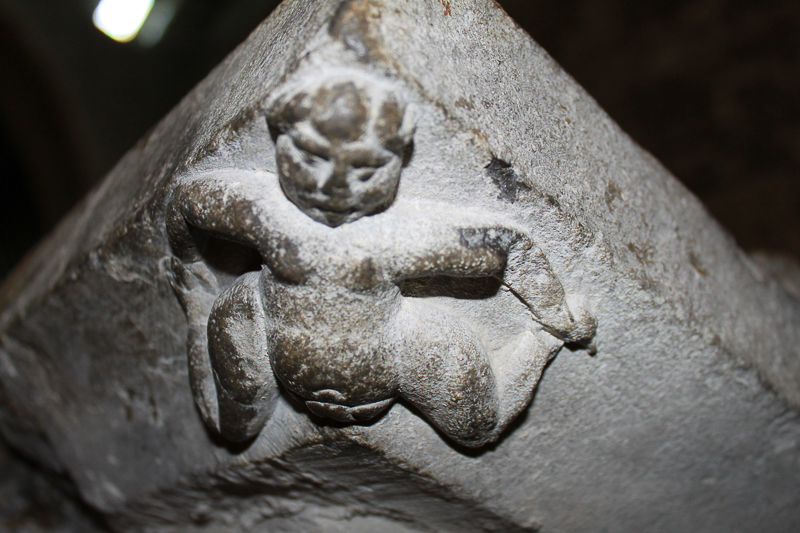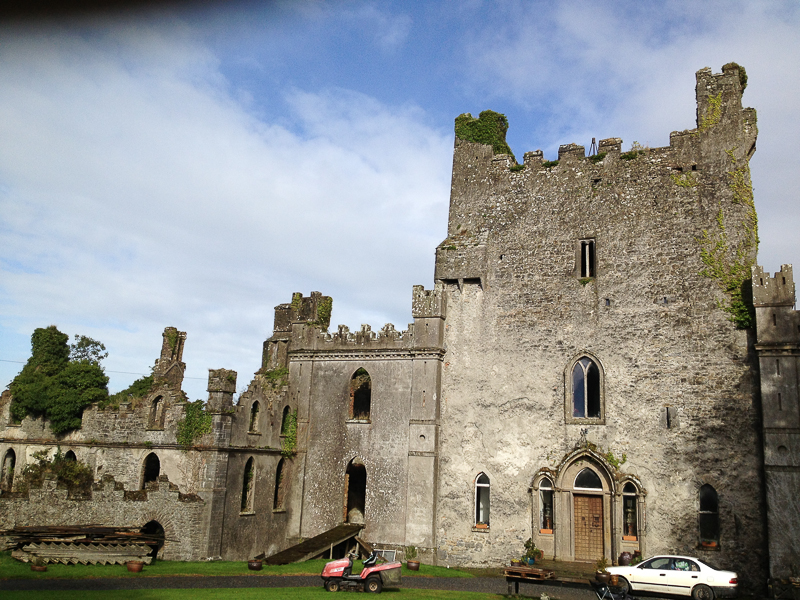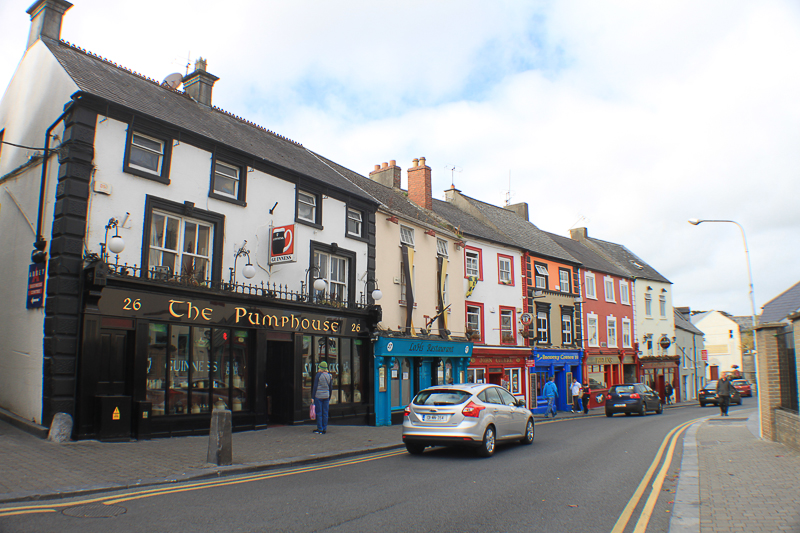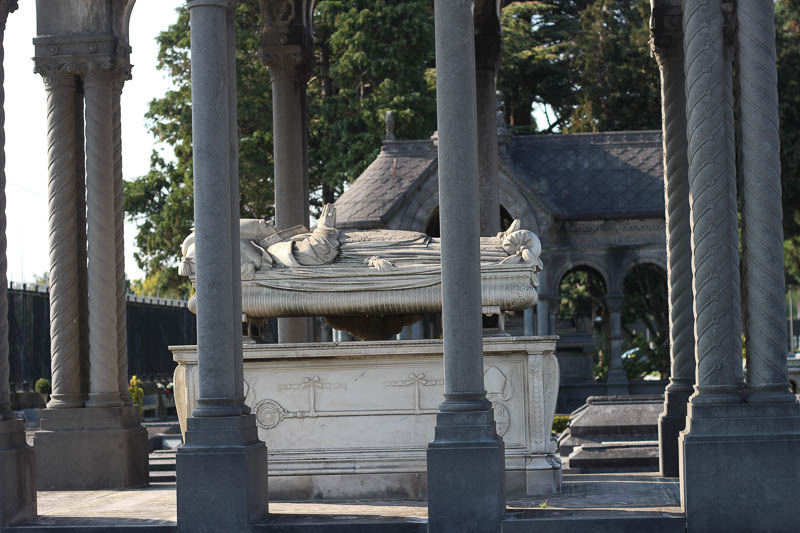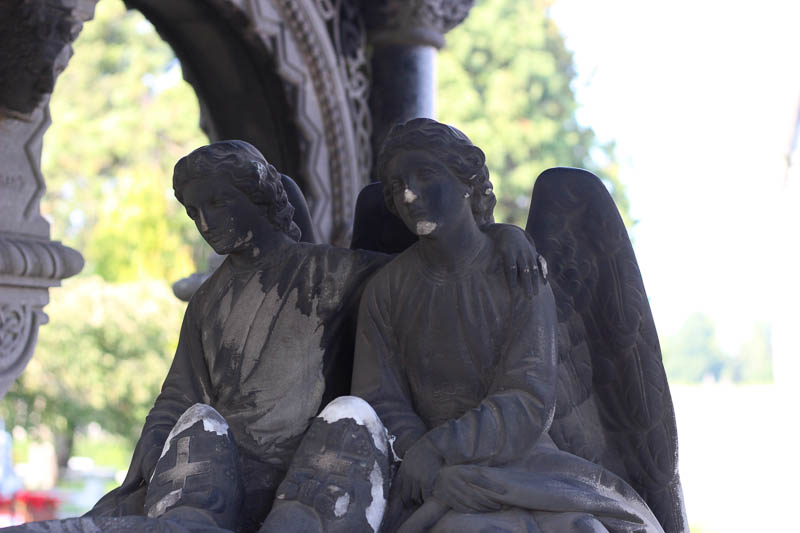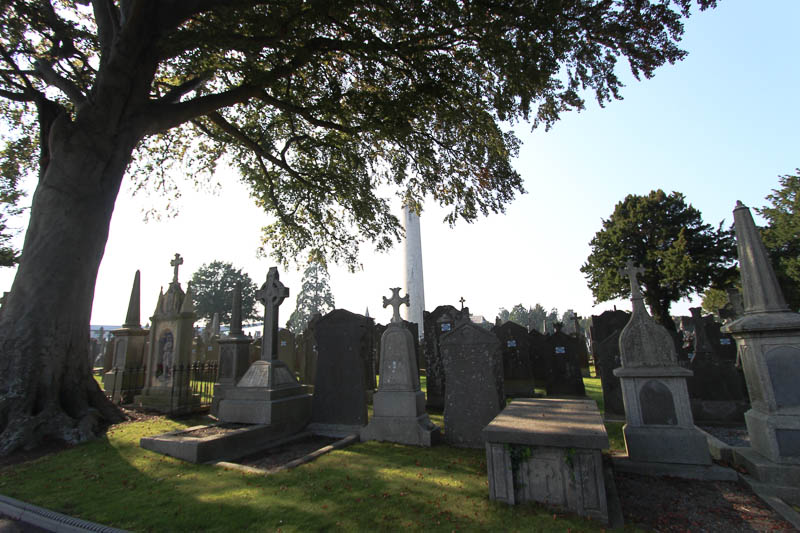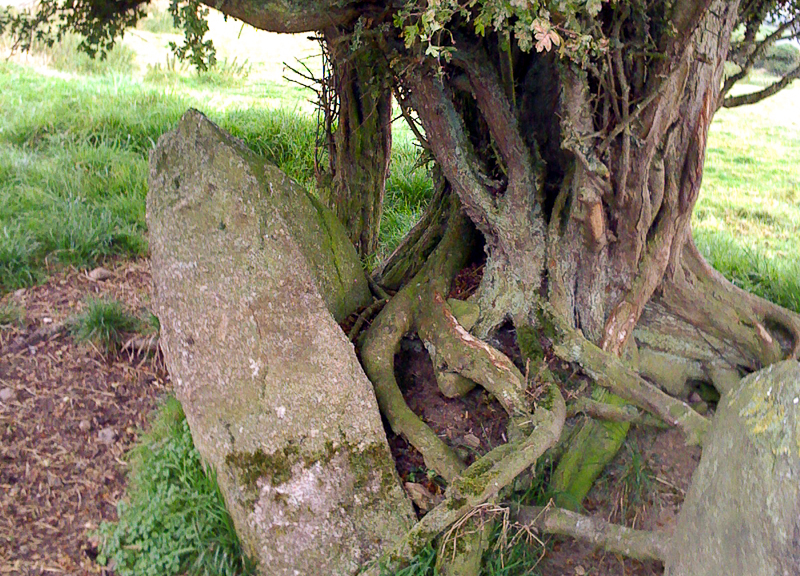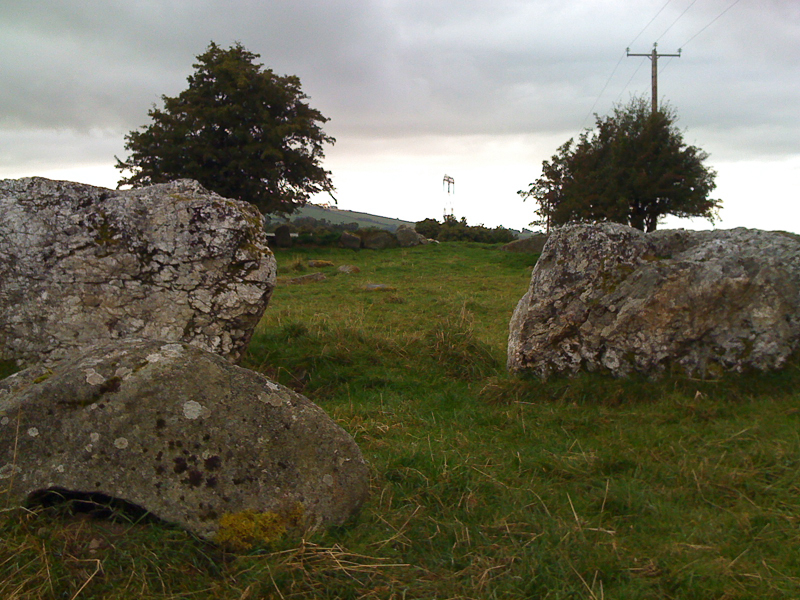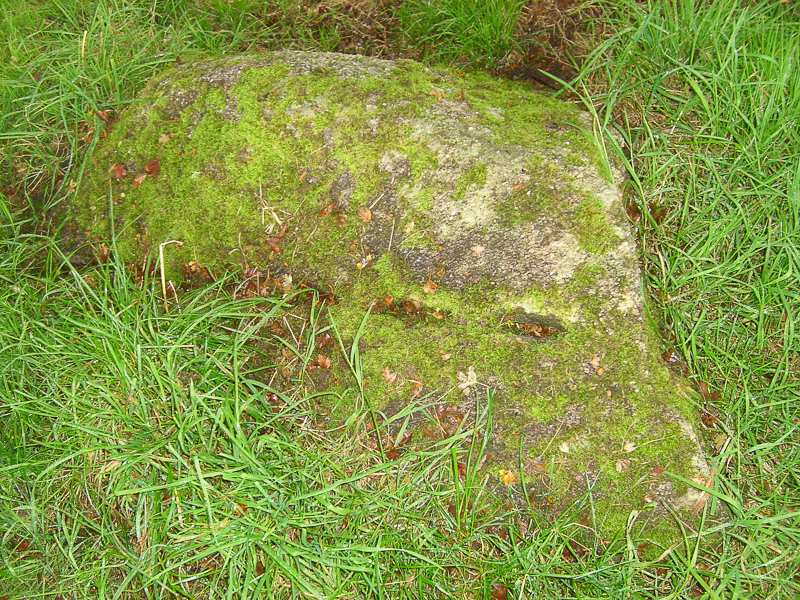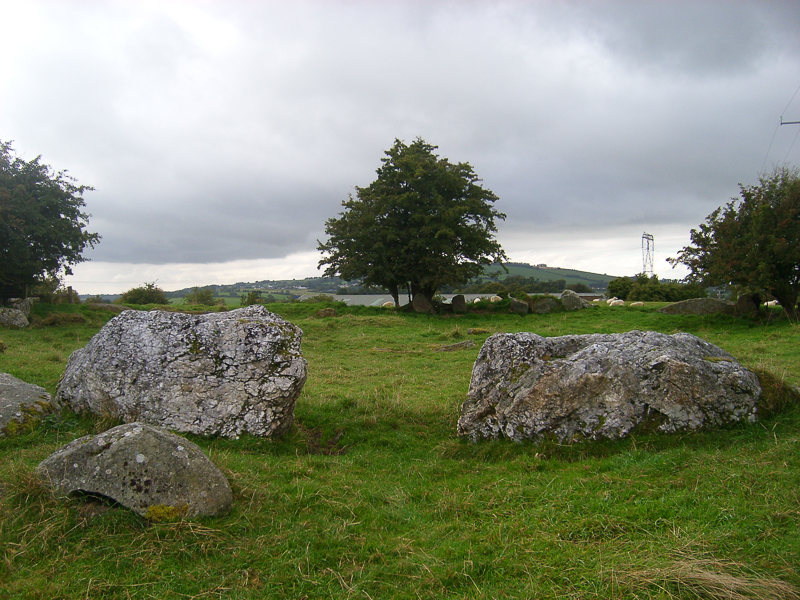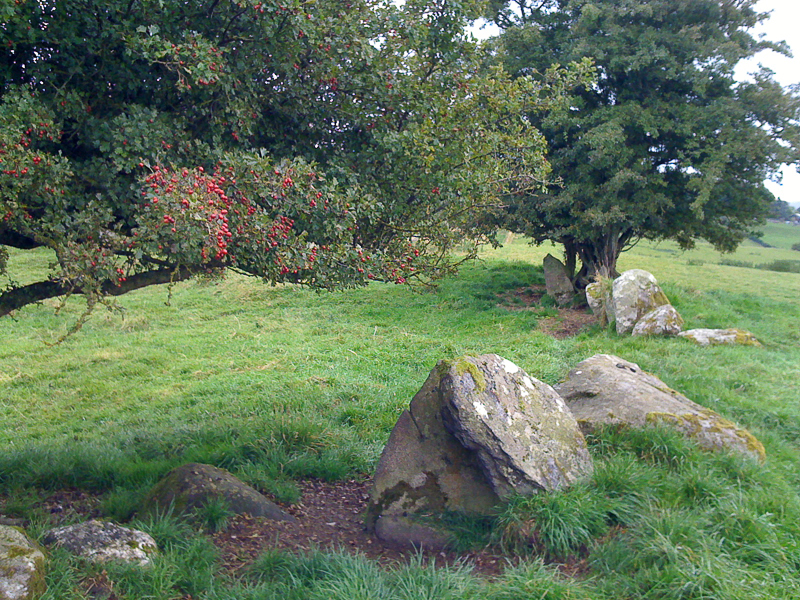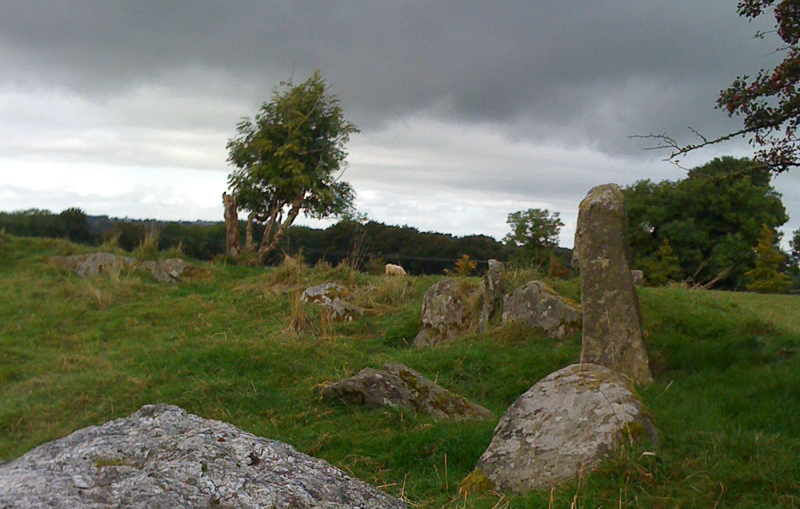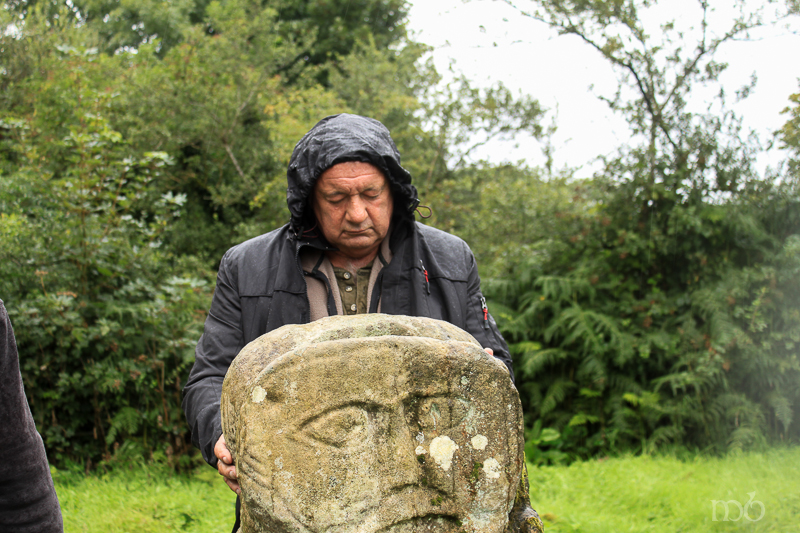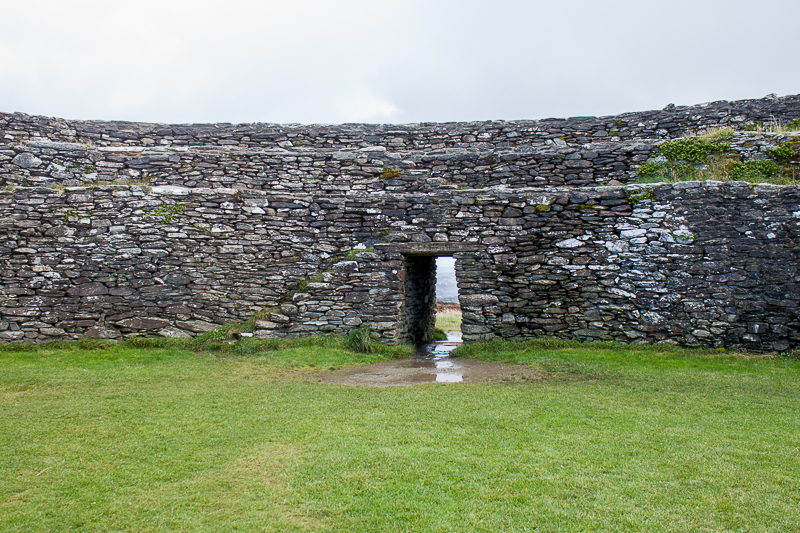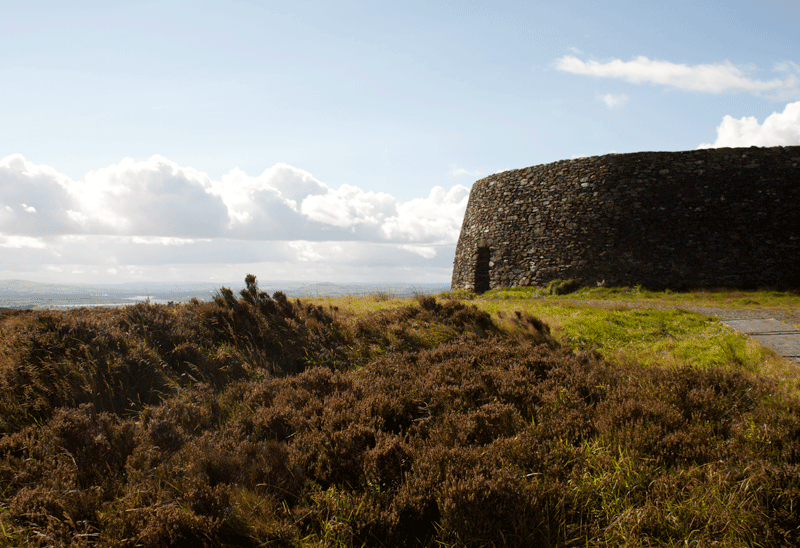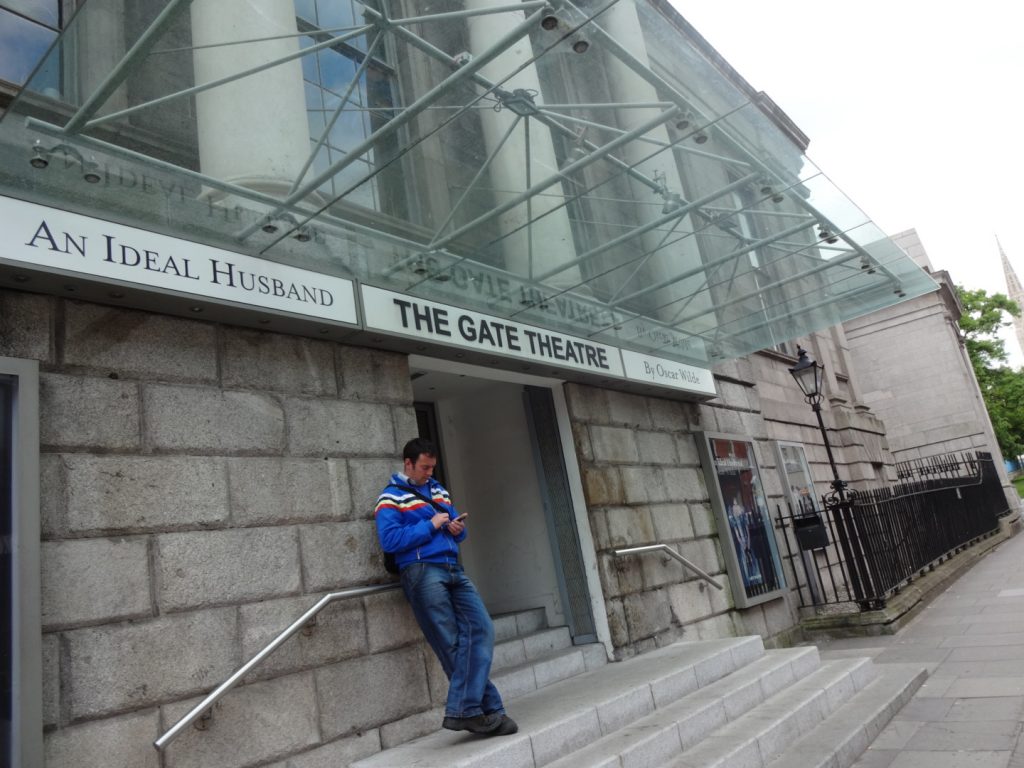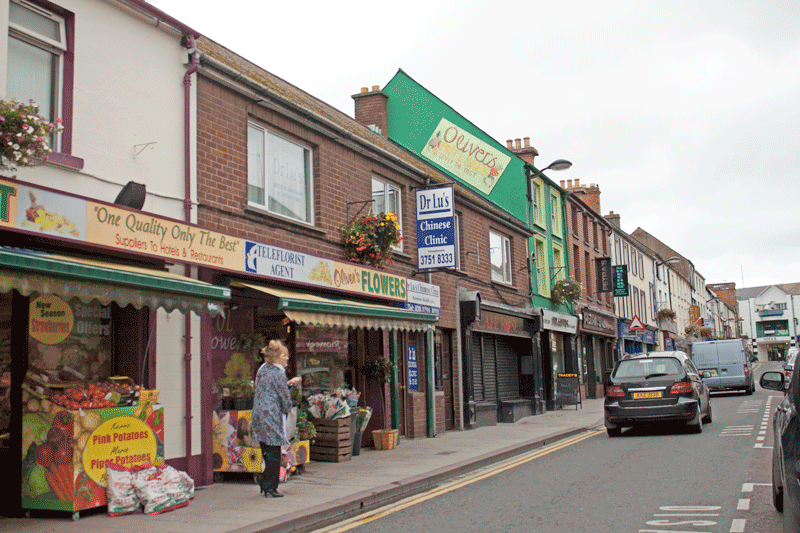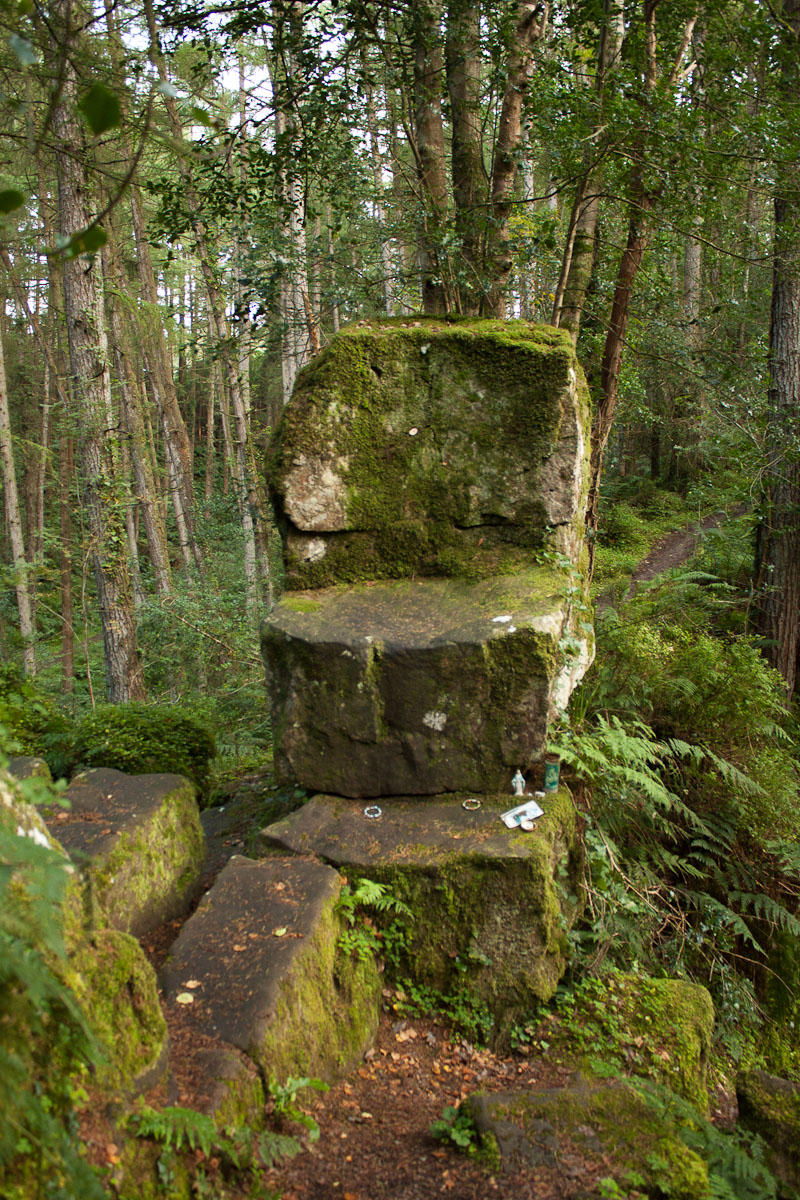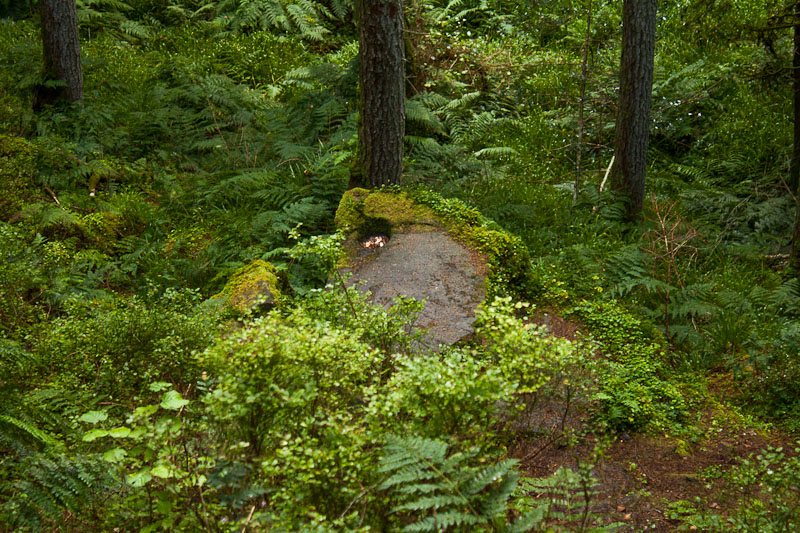The Mystical Faces of Harry Clarke in Dingle
Harry Clarke – Icons in Stained Glass

Harry Clarke,famous for his stunning stained glass windows scattered all over Ireland, crafted a series of windows depicting the life of Christ that now hang in an obscure chapel in Dingle. To see one Harry Clarke Window is a gift. To see twelve at once is an mystical experience.
The Dingle Peninsula in Ireland’s south west corner is a magical place. Apart from the well-known sites like Slea Head, Gallarus Oratory, the mysterious Blasket Islands, bee hive huts, and Mount Brandon, the Harry Clarke windows in the Chapel of the Sacred Heart at the old convent of the Presentation Sisters are hidden jewels often undiscovered by the traveler who walks the streets of Dingle town.
Perhaps it’s no wonder that Dingle – one of the thinnest places in Ireland – drew unto itself one of the largest collection of Harry Clarke windows installed in a single location.
The windows are housed is a small chapel situated next to St. Mary’s Church on Green Street. Visitors can stop in the An Diseart Visitor Centre and ask for a guided tour, or contact the Centre ahead of time and secure a appointment to view the windows. The young woman who conducted my personal tour explained that this was once a convent and the chapel was solely for the nuns. They were the only beneficiaries of this magnificent art except for on rare occasions.
Illustrator turned Stained Glass Artist
Harry Clarke was the son of a craftsman. He started working with stained glass under his father’s direction when he was in his teens. After he completed his education, Harry Clarke began his professional career as an illustrator. His illustrations adorned books of fairy tales by Hans Christian Andersen and Edgar Allen Poe. It was Clarke’s craftsmanship as an illustrator that set his stained glass windows apart from other famous stained glass artists. The detail to fine lines and his method for using lead to carefully outline his figures was unique. His use color, particularly his shades of blue, made his windows stand apart.
This little chapel next to the grand St. Mary’s Church houses twelve lancet stained glass windows by Harry Clarke. Many churches in Ireland will claim one Harry Clarke window as an element to attract visitors. (And viewing one window IS worth a visit anywhere). But to have twelve all together in one spot is enough to take one’s breath away. Each pair of double windows depicts one of six scenes from the life of Christ – Visit of the Magi, Baptism by John the Baptist, Suffer the Little Children, Sermon on the Mount, Agony in the Garden, and Christ’s Appearance to Mary Magdalene.
The Faces in the Chapel
The faces of Harry Clarke’s characters in theses windows draw the admirer into the work of art – connecting on a deep level. The eyes of the figures follow you as you move around the chapel, and the expressions on the faces are full of emotion. They haunt you after you leave.
The series of windows transports the gazer … lifts the spirit into another realm. They stimulate the imagination.
In 1929, mystical writer George Russell (aka AE) wrote, “Harry Clarke is one of the strangest geniuses of his time … He might have incarnated from the dark side of the moon.” ~The Irish Statesman
Viewing the Harry Clarke Windows at the Diseart Centre
If you’re in Dingle, ask about the Clarke windows. Anyone can direct you to St. Mary’s Catholic Church. The former convent – now theAn Diseart Visitor Centre is next door. Only escorted tours are offered and the hours of operation for the Centre vary so call ahead and inquire about a guided a tour.
The tour takes about and hour and there are beautiful walled gardens as well as a hidden tunnel that can be explored with a guide. But make the chapel the last thing you see, because everything after that will be underwhelming.
The Harry Clarke windows in Dingle are on the Places of Resurrection Tour in 2015
12 Pictures that Will Make You Want to Tour Ireland
Ireland and its thin places have such a draw for those interested in traveling a bit deeper into the landscape. Here are 12 pictures that show some of these amazing places. All of them are on our Castles, Saints & Druids Thin Places tour this September 2014. Join us!
1. The King Oak
The King Oak is said to be between 500-800 years old. It’s part of an ancient oak forest once sacred to the Druids, then later the site of a monastic community. The forest entombs Charleville Castle, a gothic-style castle built from 1798-1812. The King Oak ranked #3 in Europe’s Tree of the Year 2013 and it’s a familiar old spot to the people around Tullamore. Many a romance started and ended beneath the branches of this tree. The spread of the lower branches spread out over 150 feet from end to end. This oak is set in an ancient grove with other trees that are hundreds of years old. When the British invaded Ireland and occupied the country, they ravaged the land, stripping it of all its forests, then exported the wood for profit. Fortunately this oak forest was part of a 1700 acre “gift” from Queen Elizabeth I to the Moore family. The gentry tended to keep the trees on land around their homes. This oak forest has been considered magical for centuries.
2. Charleville Castle
Charleville Castle was built by the Earl of Charleville between 1798 and 1812 in an ancient oak forest near Tullamore. The site was formerly occupied by the Lynally monastic community, and before that was used by the druids for sacred rituals and ceremonies. It is currently owned by a non-profit that uses volunteers from all over the world to help restore the castle and bring it into a self-sustaining existence. The caretaker says that the designers of the castle were Masons and positioned the round towers on crossed ley lines which creates a powerful energy field in the tower rooms. The caretaker also has experienced ghostly sitings that include druids, the Earls of Charleville and the castle designer. Many believe that a little girl named Harriet who was the daughter of the third Earl of Charleville haunts the back staircase where she fell to her death after trying to slide down the bannister. Charleville Castle and its surrounding oak forest is considered one of the scariest places in Ireland.
3. Castleruddery Druid Stone Circle
Castleruddery Stone Circle in County Wicklow is a Bronze Age Druidical circle once used for ritual. There are a total of about 40 stones on the site but the circle itself has about 20 standing stones places on a raised embankment. This would have been a place of great importance based on the geographic layout of the stones, embankment and ditch that is dug outside the embankment. Two large quartz stones mark the portal (entrance) of this circle. Quartz in an amplifier of energy and believed to have healing properties. Some locals from this area believe this stone circle has healing properties. There is also a fairy tree in the circle (pictured here). The roots are wound around a standing stone. Some of the stones have cup marks carved into them and notches carved across.
4. Glendalough
Set in the Wicklow Mountains, Glendalough (meaning valley between two lakes) features the ruins a Medieval monastic city founded by St. Kevin in the 6th century. In the last two centuries it’s been used as a graveyard for local families, but the old bones of the monastic city can still be seen in the hilly landscape. ruins of churches, round-towers, buildings dating from the 9th to 13th century make this site absolutely enchanting. The views of the glen and lakes and babbling stream connecting the lakes are also remarkable. Our Castles, Saints and Druids tour group will be overnighting in the Glendalough Hotel in September.
5. St. Kevin’s Kitchen – Glendalough
St. Kevin’s Kitchen is a 12th century church in Glendalough, and often used as a defining landmark for the ancient monastic city. The church has a stone roof with a round tower built into the roof. Round towers were used for bells, for look-out stations to see people approaching from a distance.
6. St. Berrihert’s Kyle – Glen of Aherlow
St. Berrihert’s Kyle is a round structure built by the local people from pieces of an old monastic ruin. It was made to mark a Cillini or burial ground for unbaptized babies and others not qualified for sanctified ground. The kyle is a complete circle set in an oak grove in the Glen of Aherlow in County Tipperary. Pilgrims travel from all over to pray here. They leave behind devotional tokens – some very rare. These tokens are offerings left in hopes that their prayers will be answered. There is also a holy well (more like a small pond) nearby that is flanked fairy trees covered in clooties, also left by pilgrims.
7. The Rock of Cashel
If the Rock of Cashel doesn’t inspire you, nothing will. This cluster of ruins atop a rocky hill in County Tipperary can be seen for miles. It always reminds me of Emerald City in the Wizard of Oz. The Rock is set in the middle of agricultural land known as the “Golden Veil” because of the bounty of food it produces, and that land is ringed by mountains. The views from the Rock are stunning, and the energy and power of the site radiates in almost fearsome abundance. This is a must-see site in Ireland.
8. The Hill of Tara
This is the Lia Fáil or Stone of Destiny perched atop the Hill of Tara – a corronation site once used for crowning the High Kings of Ireland. An old legend states that if the true High King was crowned, the Lia Fáil would literally cry out or roar. If this stone looks phallic to you, that’s because it’s meant to look that way. The ancient pagans didn’t have the sexual hang-ups of our present world. They believed that male and female were two aspects of the Divine. In this case the stone may represent the male Divine aspect in union with the female aspect (the earth). The stone is believed to have magical properties – those properties were demonstrated the roar of the stone during coronations. The Hill of Tara has a brilliant earth energy.
9. Newgrange Passage Tomb
Newgrange, the Boyne Valley is Ireland’s oldest building remaining fully intact. The tomb dates back 5000 years, predating the pyramids of Egypt, Stonehenge and all the other tombs and prehistoric enclosed structures in Ireland and Britain. Newgrange was a center for spiritual ritual and has remained intact since the Stone Age. The inside is large with a center chamber large enough for 20 people to stand and three side chambers. The entrance is shown in this image (center). Above the opening the tomb is a stone lintel which allows the passage of light to penetrate the pitch blackness of the tomb during the sunrise on the Winter Solstice (December 21) – the shortest day of the year. Visitors to Newgrange can walk deep into the passage tomb and a guide uses an electric light-beam to demonstrate the shift from dark to light during the Solstice sunrise.
10. Sheela-na-Gig – Kildare
There are people who search for Sheela-na-gig’s all over Ireland and in other Celtic countries. These figures are usually primitive carvings in stone that depict a female revealing her genitals with legs spread wide open … usually with some kind of angry face. Some say the Sheelas were fertility goddesses, others believe they a defense against evil or bad energy similar to the function of a gargoyle. They are often found over doorways or beside entryways in churches and castles. Ireland has the most known Sheelas of any country (101). This Sheela-na-gig is hidden under the altar at St. Brigid’s Cathedral in Kildare. As our Thin Places tour group wandered through this beautiful and ancient cathedral, one of the cathedral staff people pointed this out to me. It was tough getting a picture (had to practically lay on the floor), but it was well worth it.
11. Leap Castle
Leap Castle is still being restored by its owner, musician Seán Ryan and his wife. The castle located in County Offaly was built by the O’Bannon clan in the 13th century, and later came under the ownership of the O’Carroll clan. It is said to have been built on a former ceremonial site used by the druids, and archaeologists estimate there has been human habitation on the site since the Iron Age (500 BC). Leap is famous for being haunted, probably because of the violence that has occurred there. The O’Carroll clan, warring over leadership resolved the conflict when one brother (a priest) was saying mass for his gathered family members in the chapel on the upper floor of the tower. Another brother burst through the door and murdered the priest with his sword in front of the family. Thereafter the upper floor of the tower was known as “the Bloody Chapel.” Leap also has an “elemental” or non-human spirit that has been seen as a shadowy figure that makes mischief.
12. Kilkenny – Downtown
While we all love thin places and mystical landscapes, no travel to Ireland is complete until the visitor gets to experience the Irish culture, and Kilkenny is certainly a vibrant town of culture. The name Kilkenny originates from the Irish words that mean Church of Canice and St. Canice’s Cathedral and round tower sitting atop a hill anchors one end of the city while Kilkenny Castle anchors the other. In between are shops, galleries, pubs and heritage sites. This was once a hub for monastic communities. The Grey Friars were here as were the Franciscans – St. Francis Abbey is now home Ireland’s oldest operating brewery which makes Smithwicks and Kilkenny beer. Walking the Kilkenny’s downtown is an excellent way to engage in conversation with the Irish, and the most memorable thing you’ll do on a trip to Ireland is engage with the Irish people.
All of the pictures above and the sites mentioned are part of our Castles, Saints and Druids tour for 2014. It runs from September 11 – 21st. It is a small, specialized tour focused on mystical sites ranging from the ancient druids to the monastic communities through the times of the British occupation. The cost is $2099 per person + airfare. For more details check out the Tour Itinerary.
Glasnevin Cemetery – Memories in Stone
Some believe that stones and trees hold on to the memories of a place. I believe that’s true. The stones in Glasnevin Cemetery in Dublin go on forever. Over 1.5 million people have been buried there since its establishment in 1832, and the markers tell the story of Irish. I went to Glasnevin for those stories. I stayed and was overcome by the art and power of the stones.
Here is a short video featuring some of these remarkable stones.
Glasnevin was established after Daniel O’Connell got legislation passed that allowed Catholics to practice their burial rites and traditions in public. Prior to this, Catholics were oppressed and the “penal laws” prohibited them from the public practice of religious ritual. At Glasnevin, Protestants and Catholics were buried in one place. There was even a place for stillborn children, or children who died before being baptized.
When I planned my trip to Glasnevin, I intended to see the graves of Michael Collins, Eamon de Valera, Brendan Behan, Maud Gonne and Constance Markievicz. My friend Kathy and I spent hours there … not looking for certain graves, but simply looking at grave after grave, stone after stone. The craftsmanship and art in preserving memories and marking places of importance is overwhelming. One loses track of time.
Glasnevin is a thin place.
If you plan a visit to Glasnevin, be prepared to walk and give yourself enough time to wander, to think, to get inside the memories that marked here in gardens of stone that go on forever.
Castleruddery Druid Stone Circle – Wicklow
Castleruddery Stone Circle – also known locally in Wicklow as the “Druid Stone Circle” sits in a clearing at the mouth of the Glen Imaal. Lugnaquilla, the highest peak of the Wicklow Mountain Range is visible in the distance. If I had to pick 3 favorite stone circles out of the scores I’ve visited in Ireland, they would be Uragh, Beaghmore and Castleruddery.
Castleruddery Stone Circle in on our Castles, Saints & Druids tour in September of 2014
There are about 30 stones in this disheveled circle which measures about 100 feet in diameter. Whitethorn trees have grown up in the circle – one actually clutches stones in its roots. Why is this one of my favorites? Energy. There is a an old, ancient energy about Castleruddery. A sensitive person can feel the vibrations from the circle on the approach.
The circle dates back likely to the early Bronze Age (2500 BC), and it has two qualities not typically found together in stone circles –
- It is a recumbent stone circle that follows certain astronomical patterns. Typically these stone were used for ritual practices by the druid class and probably used as a means to chart the seasons.
- The circle is on a ringed embankment with an opening in the east, and aerial views suggest that embankment is on a third embankment. This was a typical setting for building defensive structures – like forts and defensive castles.
Stones outside the circle near the eastern opening of the embankment could be directional stones pointing to the circle – sort of acting like wayside markers.
What we can safely surmise is that Castleruddery Stone Circle was an important place of ritual and probably had a grand entrance.
The Stones of Castleruddery
This circle has the most amazing stones. The most impressive are the portal stones. They are massive white quartz recumbent stones that mark the entryway (east) into the circle. Quartz was significant in druidic circles. It reflected the light rather than absorbing it, and quartz retains energy and absorbs energy from its surrounds.
Local say that Druids still use Castleruddery stone circle for rituals, and that the circle is believed to have healing properties.
Some of the stones in the circle are bullaun stones – stone with cup markings. In the Celtic tradition, these bullauns were created to hold rainwater at a sacred site, and the water collected would have healing properties. There are also stories of locals putting milk (a sign of purity) for the people of the Sidhe in the indentations of bullauns.
But sometimes the circular markings are for other purposes like being indentations to support other circular stones that were used as cursing stones or blessing stones (depending on which way a person turns the stones). In other cases markings on stones – particularly recumbent stones (flat lying stones) – charted an astronomical event like the setting of the sun on a particular day. Carvings could also be directional meant to lead the traveler to a destination.
No one can be certain what the markings on the Castleruddery stones mean. But they are interesting if nothing else.
The Energy of Castleruddery
Ground yourself and calm yourself just before you enter Castleruddery through the quartz portal stones, and you may be able to feel the energy, the vibrations that come through the circle.
Ritual practices ignite energy and also revive it. Energy that is ancient can lie dormant and a stone circle can feel stagnant or dead. But when people come back to a place and practice rituals, they rejuvenate the old energy, calling it back, reigniting what was once there – stirring up the old and mingling it with the new. The circle feels like it once did – vibrating with energy.
This is how Castleruddery feels to me. The strong vibrational pull is similar to Cashelkeelty or Uragh in West Cork and Beaghmore in Tyrone or Caldragh in Fermanagh (even though Caldragh is not a stone circle but the home of the Boa Island Janus figures). There is a magic about the stones.
The name Castleruddery comes from the Irish Caisleán an Ridire meaning Castle of the Knight.
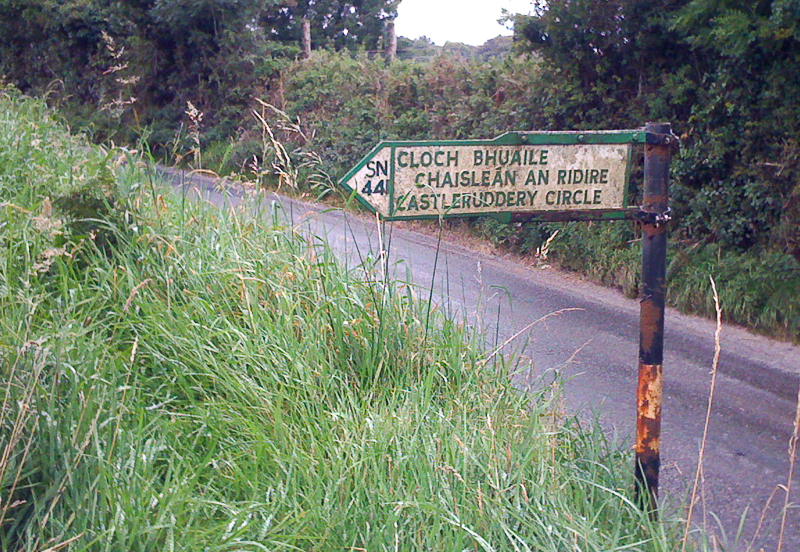 Castleruddery Stone Circle in on our Castles, Saints & Druids tour in September of 2014
Castleruddery Stone Circle in on our Castles, Saints & Druids tour in September of 2014
6 Reasons to Tour Ireland’s Thin Places
On a thin places tour of Ireland, the traveler focuses on places where the veil between this world and the eternal world is thin. In these mystical places spiritual energy is high, and there is a strong sense of the life force that charges every living thing. Thin places have a special energy, a vibration that resonates. The landscape has a magnetic pull.
While thin places exist everywhere, Ireland has hundreds scattered over a country that is barely the size of West Virginia or Vermont. If you are intrigued by ancient standing stones, old oak trees, monastic ruins; if you’re inspired by castles, intrigued by stories of heroes, giants, goddesses and kings; if you hunger for a connection with your ancestors or long to go deeper into your own spirit and soul, then you’re ripe for a mystical tour of Ireland’s thin places.
Here are six reasons to tour Ireland’s thin places:
1. You’re Searching … Spiritually
Perhaps you are longing to know more about what lies beyond earthly existence. Maybe you have a desire to travel inward, a desire to belong to something greater. You love nature and know that every living thing is charged with the Divine presence. You love history and stories of your ancient civilizations.
You want to connect with an ancient landscape – to touch the Other world – to draw from it, to feel the pulse of the earth’s energy, to feel the presence of those who went before and those who will come after, to walk in a magical landscape in order to discover your own inner landscape.
Next Thin Places Tour of Ireland is September 2014. Register Today.
2. You’re Growing … Spiritually
You already have one foot in this world and one in the Other world. You may have a great affinity for trees, for stones, for wildlife, mountains and the sea. Sometimes you journey during meditation. You believe there are no coincidences. To you coincidences and synchronicity are the language of the spirit world. Sometimes you can sense the memories of the past in a particular place. You are intrigued by old stones, by art, poetry and music. They transport you into a higher existence. Yet though you have these sensitivities, you know there is more. You’re looking to perfect your gifts and you’re hungry for a deeper understanding.
3. You’re Already Using Your Spiritual Gifts
Perhaps you’re a healer, a priest, a spiritual director, and energy worker, a psychic medium, a mystic, a therapist, or someone who offers powerful prayers for others. You’re able to walk in both worlds and have an internal sense of the Divine. You successfully communicate with spirits and otherworldly beings. You may have a strong understanding of earth energies, and can feel the vibrations in a highly charged site. You may have an understanding of the spiritual power in ritual and devotion (rounds of prayers such as the rosary, ritual practices, meditation, pilgrimage, visits to holy wells).
4. You Are a Teacher
You may be responsible for teaching others spiritual or healing practices… a practitioner who trains others, a mentor, an artist, a therapist. In a world where spiritual leaders are scarce and negative forces threaten to quench the zeal and passion of those who seek a higher existence, being in a mystical landscape refreshes and strengthens the soul. Creativity thrives. Needed spirit guides appear. Lifelong friends are made.
5. You’re in Need of Healing
Whether it’s physical, emotional or spiritual healing you need, Ireland’s thin places have a strong, healing energy. The soul soaks up this energy with every step into the mystical landscape.
6. You Love Someone Who Fits the Descriptions Above
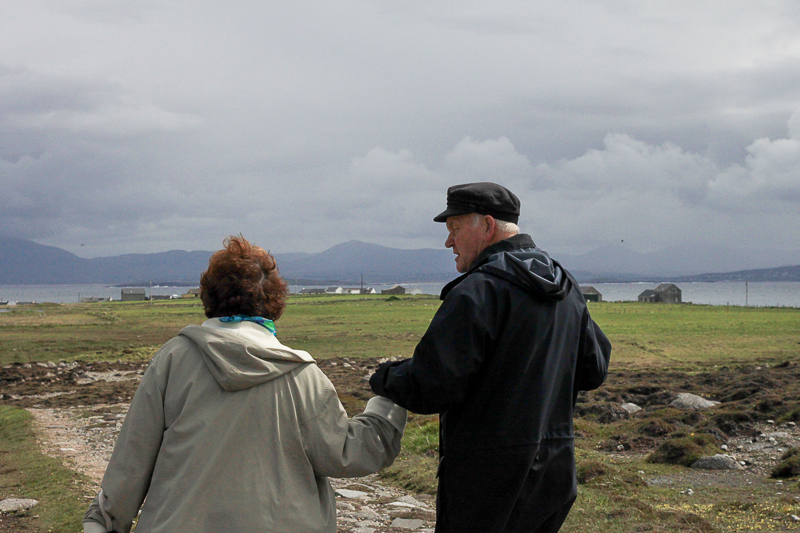 People on spiritual journeys often reach out for the support of friends or family. While some like a solitary experience, others want a close companion or soul mate to travel with them. Though you may not be searching spiritually, or looking to deepen your own understanding, you may be called to support someone who is. Often times people who support others on a thin places journey will find unexpected benefits in their own lives. It may be nothing more than relaxation and a calming of the spirit, but if you’re asked to go on a thin places tour, it’s most likely meant to be.
People on spiritual journeys often reach out for the support of friends or family. While some like a solitary experience, others want a close companion or soul mate to travel with them. Though you may not be searching spiritually, or looking to deepen your own understanding, you may be called to support someone who is. Often times people who support others on a thin places journey will find unexpected benefits in their own lives. It may be nothing more than relaxation and a calming of the spirit, but if you’re asked to go on a thin places tour, it’s most likely meant to be.
Why not consider joining us on a thin places tour of Ireland?
Grianán of Aileach – the Sun Palace
Grianán of Aileach or Grianán Ailligh is a cashel on the Inishowen Peninsula in County Donegal. Also known as the “Sun Palace,” it was the royal citadel of the northern Ui Néill (O’Neills) from the 5th to 12th century.
The Cashel
The cashel dates to the third century and archaeologists suspect it could have been built on a former Neolithic sacred site or burial mound. Experts in Irish culture and heritage believe that the mound was used for ritual purposes as far back as 1700 BC and was the center of one of Ulster’s ancient kingdoms – and later the political center of the ruling O’Neill’s and later the O’Donnells. This would have been the royal center, where kings were crowned and rituals carried out as well as a defensive structure.
Though the actual ring fort was probably built in early Christian times, the three concentric rings surrounding the cashel as well as artifacts discovered in the surrounding rings suggest this spot was used for ritual much earlier. The cashel itself is 77 feet in diameter and its walls are 13 feet thick with chambers embedded. Inside the circle are stairways built into the inside walls the lead to ringed seating areas – like an amphitheater. This seating gallery would hold hundred of people who could witness inaugurations and other ritual ceremonies.
The City of Derry’s website has a video embedded that was filmed inside the cashel and shows a reenactment of a medieval celebration
From the top of the ring one can see for miles in every direction. Counties Tyrone, Donegal and Derry are in view with mountains, cliffs, open pastures, villages and beaches. Lough Foyle and Lough Swilly, the two bodies of water that flank the Inishowen Peninsula swirl about in that landscape. The peninsula rolls out like a blanket from this vantage point, eventually vanishing in a misty gray horizon (on a sunny day, that is). It’s easy to understand how the cashel on dominated the region and became as the political center. Its remarkable disk-image capping a hill 800 feet above sea level is visible to so much of the surrounding countryside.
Tied to Celtic Mystery
Folklore suggests that prior to the cashel, this hill was associated with deities linked to the sun. In Irish “Ail” refers to stone. Grianán in Irish means “sunny spot” or sun temple. So the name could refer to a stony sun temple or palace. But according to author Cary Meehan who wrote Sacred Ireland, it can also mean sunny disposition or of the sun. In Celtic mythology Grainne was the sister of Aine – goddes of the sun, and though Grainne was known as goddess of corn or grain (springs from the earth after being nurtured by the sun), both sisters are said to have been birthed by a sunbeam or “of the sun.”
There is also a tradition that the temple was built by Daghdha, the good god or god of the earth. He was known as the King of the Tuatha dé Danann, a race of supernatural beings descended from the Goddess Danu. They inhabited Ireland before the Celts. This tradition has Daghda building the fort to protect the grave of his son. A variation tells of giants building the hill and the Grianán on top a residence for the shining ones who gave birth to the children of the sídhe. All of these traditions link the hill and the fort on top with supernatural beings, to unseen energy and power and a link to the Otherworld.
Cashels were built for defensive purposes, but circles are also linked to Irish ritual and spirituality. The shape represents a deeper meaning. Stone circles, carved spirals on implements and burial stones, circular mounds covering passage tombs indicate this. There was also a later belief that circular buildings had no corners for evil entities to hide. Thus one can’t dismiss the spiritual importance of Grianán of Aileach, even though the cashel marked it as a secular site. The traditional beliefs embedded in the Irish life permeated all they did. This circular fort sitting atop three concentric circles on a circular hill was built with circles in mind. And the site has a powerful energy about it.
Originally the cashel had been the stronghold of the 4th century chieftain, Niall of the 9 Hostages. Later it became the stronghold of the O’Neill kings and the O’Donnells. The cashel was mostly destroyed in 1101 by the king of Munster, Murtagh O’Brien and his army in retaliation for the O’Neill’s destruction of his palace in Clare (Kincora). After they sacked Grianán of Aileach, Murtagh O’Brien told his army of a thousand men to each take a stone from the cashel with them so that the fort could not be rebuilt.
The cashel was later restored again in 1837 by a Dr. Bernard from Belfast. And in 2007 the Irish Office of Public Works restored it to the excellent condition it is in today. Some say it is over restored. But over-restoration has not blocked the ancient energy that still apparently seeps from the ground and surroundings.
The Energy Linked to Grianán of Aileach
Irish Musician, Tommy Makem in his book Tommy Makem’s Secret Ireland wrote about his experience in trying to tape a television interview with Derry songwriter, Roy Arbuckle inside the cashel . Arbuckle laughed and told Makem that they’d never be able to record inside the walls. Makem couldn’t see any reason why it shouldn’t work.
But it didn’t work. Within a minute the sound engineer notice erratic movements on the meters which he couldn’t correct. The struggle continued for an hour and a half. They finally eked out 15 minutes worth of an interview, and as soon as they were done, all the batteries went dead. Somehow, Arbuckle expected this difficulty. Makem writes, “Roy seemed to understand the workings of some hidden forces in this magical place. He was chucking all the way back to Derry.”
It is true that Grianán of Aileach has an energy about it. One feels it on the walk up the hill to reach the cashel. It’s mad windy on that hilltop but as soon as you enter the linteled doorway into the ring, all the sounds of wind cease. Everything is suddenly still, and there is a strange silence. As soon as I crossed that threshold my imagination moved immediately to those who were in this space before… the sounds, the voices, the cheering, the shouting almost as if an old movie was playing in my head.
The entrance into the cashel is a threshold the opens into a place of different energy.
Over-restored or not, that energy is still present and the views of the surrounding landscape are some of the best I’ve seen in Ireland. Standing on the top level of the cashel ridge I surveyed the breadth of three counties – their pastures, mountains and Loughs Foyle and Swilly. The oneness of Ireland then and now is knitted together in that view.
One can see the approximate location of Rathmullen, a village on the west bank of Lough Swilly. It was from there that Hugh O’Neill and Rory O’Donnell left on a French boat bound for Spain one midnight in September of 1607. With 90+ relatives they sailed out of Lough Swilly changing the Irish social and political landscape forever. It marked an end to the old Gaelic order. An order of Chieftains and clans and common beliefs and the practice of rich traditions rooted in an ancient time.
And behind the fleeing earls was Grianán of Aileach, a remnant of old Ireland. In its time it was a great royal center, second to the Hill of Tara. An ancient road links them to each other. There is a legend of a cave in the hill beneath the cashel where the horsemen of the Great Hugh O’Neill rest in a magic sleep in full armor, mounted on their horses. The sleeping spell will only be broken when the next destined leader of Ulster arrives to lead them to victory.
So it seems there’s still a little magic left at Grianán of Aileach.
Sources used for writing this post:
A Traveler‘s Guide to Sacred Ireland by Cary Meehan
Tommy Makem’s Secret Ireland by Tommy Makem
Legendary Ireland by Eithne Massey
Mythic Ireland by Michael Dames
National and Historic Monuments of Ireland by Peter Harbison
Celtic Myths and Legends by Peter Berresford Ellis
Goddess Alive!: Inviting Celtic & Norse Goddesses Into Your Life by Michelle Skye
From Inishowen Buncrana Calling, the Heritage of Eoghain website by Brian Lace
What to See in Dublin
 Knights of St. Patrick – St. Patrick’s Cathedral, Dublin
Knights of St. Patrick – St. Patrick’s Cathedral, Dublin
What to see in Dublin – Ireland’s biggest City?
We start almost all of our Thin Places mystical tours in Dublin because that’s where the airport is located. But how to choose what to see in Dublin? But being a bustling international City, Dublin doesn’t seem like a place one would find sites of high energy vibration or a sense of walking in two worlds. But since almost all international tourists enter the country through this city it’s worthwhile to mention some sites worth seeing.
Certainly among those would be the two Cathedrals south of the River Liffey – Christ Church Cathedral and St. Patrick’s Cathedral.
 Garden of Remembrance – Children of Lir
Garden of Remembrance – Children of Lir
There are many thin places in Dublin. Ancient Holy Wells of Dublin by Gary Branigan proves that holy sites are in your midst even on the busiest of streets, and Gary has identified about a half dozen right in the City Centre. Most thin places I’ve sensed in Dublin are closely related to the arts. If being in a thin place inspires artists to create and draw on other-worldly energy, then that thin-place energy that inspired them lives in the art. The art itself radiates the energy and connects with those who take the time to let it soak in. One need only to visit the Famine Memorial along the Quay or the Garden of Remembrance in Parnell Square to connect with such energy. Both are within a mile of each other in the City Centre.
But a sweet cluster of thin places are scattered around Parnell Square, named for Charles Stewart Parnell. On the south / east corner where O’Connell Street links with the square are some interesting Georgian houses, with the Gate Theater, anchoring the corner. Actors like Michael Gambon, James Mason and Orson Wells go their start at the Gate. It’s known for its productions of works by Irish playwrights including Samuel Beckett and Oscar Wilde.
Just up from the Gate Theater is the Garden of Remembrance, one of the most inspiring sites in all of Ireland. Across from the Garden of Remembrance on the north side is the Dublin Writers Musuem. It’s an excellent tribute to Ireland’s literary greats from Johnathan Swift to Brendan Behan. There’s numerous letters, books, and artifacts from some of the greatest writers in literary history such as like William Butler Yeats, George Bernard Shaw, Sean O’Casey, Oscar Wilde, Samuel Beckett and James Joyce. Some interesting personal items include Brendan Behan’s union card and typewriter, letters written by W.B. Yeats and a first edition of Bram Stoker’s Dracula. There are dozens of personal items carefully preserved and displayed.
 The Audience: Irish Writers – Blue by Mia Funk 2009
The Audience: Irish Writers – Blue by Mia Funk 2009
The Hugh Lane Gallery is also on the north side of the square, was the first public gallery of modern art in the world. It houses a great collection of Francis Bacon’s work. When Bacon’s heirs donated the entire contents of his studio in England to the gallery, careful attention was paid to recreate the studio in the Lane Gallery to closely resemble the original studio.
Chapter One Restaurant situated between the Irish Writers Museum and the Hugh Lane Gallery is one of ten Michelin star restaurants in all of Ireland (2013), a mark of excellence in cuisine and service. The owners take pride in using local artisans and food producers. They believe that drawing on local talent in the way of food growing and producing is what sets them apart from other dining venues and creates opportunities for growth.
 Patrick Conway’s Pub – where Padraic Pearse surrendered during the Eastern Uprising of 1916
Patrick Conway’s Pub – where Padraic Pearse surrendered during the Eastern Uprising of 1916
On the south side is the now shuttered Patrick Conway’s Pub, the oldest pub on Dublin’s north side. This is where Pádraic Pearse surrendered to the British after the Easter Rising failed in 1916 – which is so noted by a plaque on the outside wall. And as if echoing that association with Irish patriots, the Sinn Fein Dublin office and shop is catty corner to Conway’s pub.
Dublin is full of art, from the statues of Irish heroes on O’Connell Street to the Cathedrals (St. Patrick’s and Christ Church) to the roadside devotional statues to saints, the Blessed Virgin and Jesus. There’s much to enjoy about the city that connects with the desire for thin places.
St. Patrick’s and St. Patrick’s – Twins, Curses and Blessings in Armagh
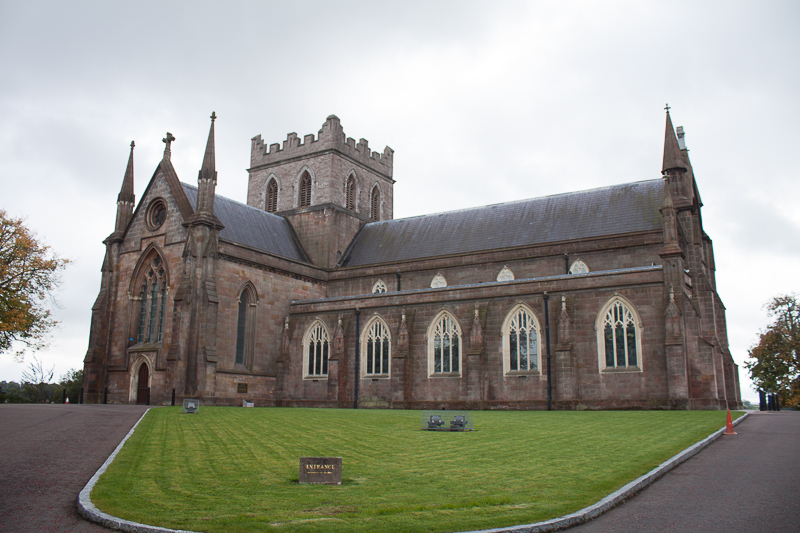 St. Patrick’s Cathedral in Armagh – Church of Ireland
St. Patrick’s Cathedral in Armagh – Church of Ireland
Coming into Armagh from the Monaghan Road one gets a dramatic view of the city skyline, especially at twilight. The view is dominated by two buildings on two hills – St. Patrick’s Cathedral and St. Patrick’s Cathedral.
Both are diocesan bishoprics, both are built on holy ground and both are tied to legends of St. Patrick. One is the Church of Ireland cathedral built on the ancient holy site where St. Patrick is believed to have built his first stone church in the 5th century. The other is a stunning Gothic-style Roman Catholic Cathedral, its cornerstone laid on St. Patrick’s Day 1840. It was completed in the early 20th century, with a serious halt to the construction during the Great Hunger. Armagh is known for being the ancient seat of the Ulster kings and the place that gave us the Knights of the Red Branch and Cuchulainn – the Hound of Ulster, a who was the Incredible Hulk of Ireland.
 St. Patrick’s Cathedral in Armagh – Roman Catholic
St. Patrick’s Cathedral in Armagh – Roman Catholic
Armagh is also a city defined by twins linked to tragedy and triumph. Armagh comes from two Irish words that together mean the “Hill of Macha” or the “Height of Macha.”
Ard means hill or height and Macha is the name of an Ulster goddess who had super powers enabling her to run faster than any living creature. When she was pregnant and near delivery, her prideful husband boasted to the local king who was also prideful about his swift horses, that Macha could outrun them. The embarrassed king ordered Macha to prove it by racing his fastest horses in a competition staged in the presence of all of his friends.
Macha begged for mercy because she was heavily pregnant, but the king refused her pleas and forced her to run the race. Macha ran – and won. All, including the king were in awe of her strength. But at the end of the race Macha collapsed and died whilst giving birth to twins – a boy and a girl, one representing a blessing and the other a curse on the Ulstermen to last nine generations. The blessing was that Ulstermen would develop great strength and be the mightiest warriors in all the land. The curse was that at the times when they are in the greatest need, they would be stricken with the pains of childbirth and be incapacitated for five days and four nights. The boy went to sea (the otherworld) and met his mother and the other gods and goddesses. The girl stayed behind, motherless in a world that exploited and oppressed her kind.
Twin Cathedrals
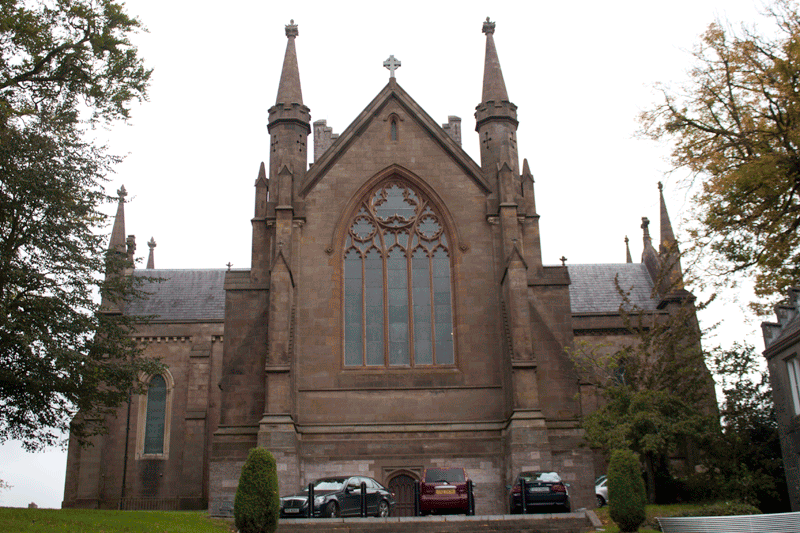 St. Patrick’s Cathedral (COI) in Armagh
St. Patrick’s Cathedral (COI) in Armagh
The twin pinnacles in the Armagh skyline are side-by-side hills each capped with a cathedral of two similar faiths. The two religions have a history of bloody conflict that goes back 700 years. They are the Catholics and the Protestants of Northern Ireland. Some say they mirror the ancient story of the twins of Macha, forced to be birthed violently because of pride, arrogance and greed. One allowed to be the warrior and the other oppressed with little power, forced into servitude. Triumph and tragedy. Blessing and curse.
But today’s Armagh shows few remnants of that conflict. People are warm and friendly, the downtown has nice shops and restaurants. It’s a busy town, but there are only scant traces of the brutal conflict that raged only a few decades. If I hadn’t been to Northern Ireland during the Troubles, I wouldn’t be able to measure the difference. But as a visiting American who traveled there both when the country was occupied and in recent years, I see the radical difference. Today there are no soldiers in the streets with machine guns, or crouching in alley ways, no razor wire, no moratorium on cameras and taking pictures, no tense people who don’t look up as you pass them on sidewalks – locals who provide no warm welcome for visitors… except for a few who were in the tourism business, and even they were guarded.
Armagh and the North – Good Times and Bad
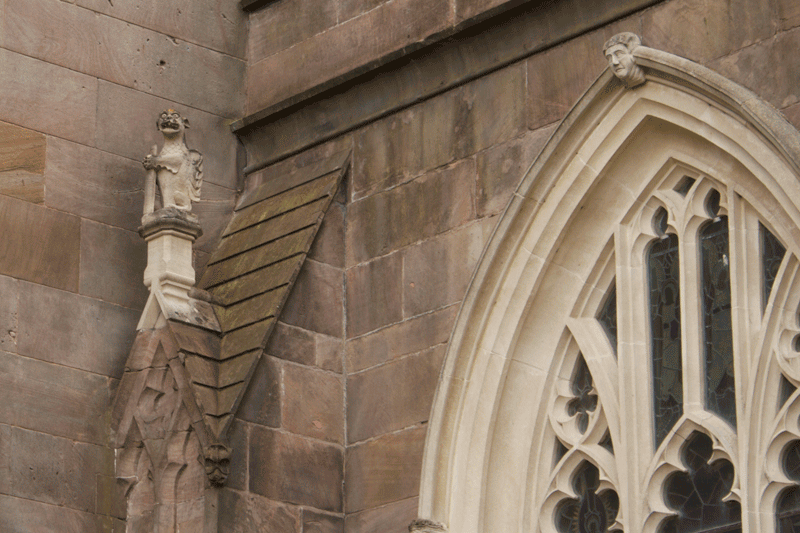 Gargoil on St. Patrick’s Cathedral in Armagh
Gargoil on St. Patrick’s Cathedral in Armagh
Don’t get me wrong. I loved Armagh then and I love it now as I love all of Northern Ireland. The only difference between the two time periods is that the curse is lifted. The two sides want to get along. They want peace. They want their children to be safe. They want to thrive economically and welcome visitors. Both sides know and always have known that they live in a magical land – a land of pristine beauty, a land of stories, a land of mystical energy. They’re eager to share their country’s treasures in the safe environment that has grown out of their commitment to peace. And visitors are very welcome.
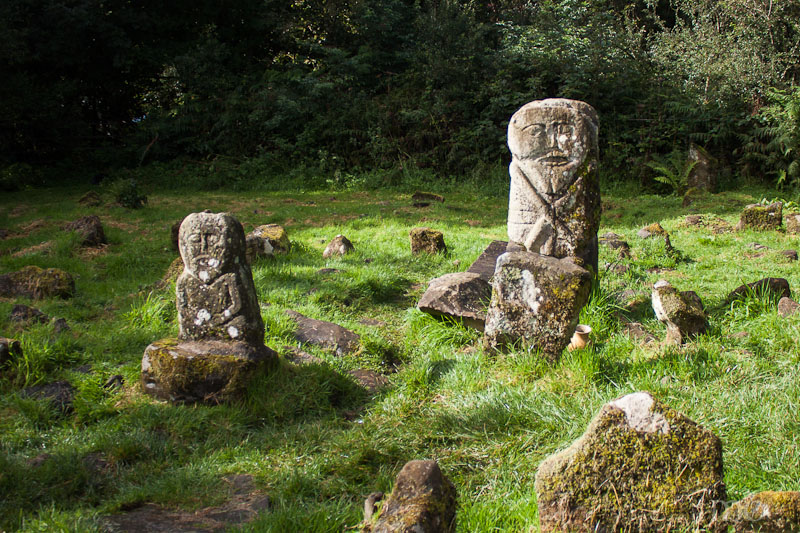 Janus figure – Caldragh Cemetery
Janus figure – Caldragh Cemetery
During all of the troubles and conflict, the ancient Janus figure still stood watch in that mystical cemetery named Caldragh in County Fermanagh. Saint Patrick’s Chair and holy well was still perched in the Altadaven Forest waiting for pilgrims to come forward and present their wishes. The sands of Whitepark Bay still sang in the wind. The stone circles at Beaghmore were still lying in wait in the shadow of the Sperrin Mountains ready to enchant the visitor looking for those spiritual ports in the storm that we call thin places. The North has always been beautiful and worth visiting, but it’s good to see the people of the North enjoying their land and each other.
Discover the North Tour
Both St. Patrick’s Cathedrals in Armagh are a part of our Discover the North tours as are St. Patrick’s Chair, Caldragh Cemetery, Beaghmore Stone Circles, Whitepark Bay and many other mystical sites.
Related Posts –
Padua House and Kathleen O’Hagan of Armagh
Armagh – Twin Symbols of Conflict and Unity
St. Patrick’s Chair – Make A Wish
The old County Tyrone legend states that if you sit in St. Patrick’s Chair located in the Altadaven Wood, and make a wish – that wish will come true within one year.
Mine did. But I’m not telling .. because you’re not supposed to tell. You’re supposed to keep it all to yourself.
This throne-like chair is carved out of one huge hunk of rock, and how it got placed so high on a cliff-like edge of the path through the woods is anyone’s guess. It’s been there for centuries.
Altadaven means “cliff of the demons.” It’s believed that this site, found deep in the thick forest surrounded by amazingly tall fir trees and hard woods with holly and ivy and fern lining the path, was once a meeting place for the druids. The legend tells of how St. Patrick came to this place and drove the demons (druids) “over the cliff.”
So what once was pagan became Christian. And what once was a center for druidic ritual became a center for prayer and Christian devotion. Today, tokens left behind at the site suggest both Christian and non-Christian people come as pilgrims to this powerful site.
There is a definite separation of energy at the entrance to Favour Royal Forest – as it used to be known. The entrance to the forest is a defined edge, with a keen sense of power. It’s a crossing, an opening into place with different energy.
The forest is thick and damp and the trees tall and slim with feathery leaves. The path is lined with ivy and fern. It is part of an old road called the Sliabh Beagh Way that runs across the countryside. It’s long been known as and enchanted road, and the forest around this part of the path is still referred to as the Fairy Green. It ascends to Pinnacle Rock which is where the Chair is.
I knew that we were on our way to see St. Patrick’s Chair because a friend brought me there. But I wonder how travelers would feel who didn’t know it was there – they were just walking this ancient path feeling the closeness of the trees and the energy around them… and then …. at the top of a rise they see this throne-like chair, six feet high, hewn from a boulder. And suddenly they know this is some special place. Some amazing place of resurrection.
From the chair there is a steep path leading down to another massive rock, this one with a small well carved out. There is water in the well and the path is lined with clooties and rags left behind by people who brought burdens to this holy well. They say the well never runs dry and that the water has healing properties. Others say the rock with the bullaun is covering an open chamber.
Tokens have been placed on the chair by pilgrims. Rosaries, holy cards, medals, statues, coins, a candle. The air is thick with wishes and dreams both recent and ancient. So many hopes are left to rest on St. Patrick’s Chair.
If you visit St. Patrick’s Chair, be sure to make your own wish. But don’t tell anyone.
The air around this place is charged with an energy that is no so gentle but more powerful, thick with presence. And the beauty of the forest is stunning. So much of Ireland is rock and open fields and rolling hills. A forest that one can easily walk through is a special to find.
If ever there was a portal into the world beyond this on, it would be here.
St. Patrick’s Chair and Holy Well are on the 2014 Discover the North Tour of Ireland.
Kildare – St. Brigid’s Holy Well (Tobar Bride)
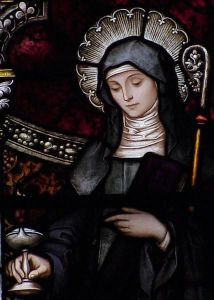 Legend tells us that St Brigid was born near Kildare to a slave mother who was a Christian and very sickly. As a child, Brigid persuaded the Druid master to free her mother which in turn freed Brigid to enter religious life.
Legend tells us that St Brigid was born near Kildare to a slave mother who was a Christian and very sickly. As a child, Brigid persuaded the Druid master to free her mother which in turn freed Brigid to enter religious life.
Kildare is one of the stops on the Thin Places Mystical Tour of Ireland – Castles, Saints & Druids in September 2014.
Since there were no convents in Ireland, Brigid began one in Kildare. The sisters of St. Brigid prayed simply and deeply and served the poor. We know that Brigid was a contemporary of St. Patrick and a strong legend states that she was ordained a bishop because of her superior knowledge and closeness to God.
Another legend is associated with the goddess or holy woman, called Brigid dating back to pre-Christian times in this region. Stories of the two women have been woven and spun into legends and tales that all point to a holy woman, who drew followers to this site and performed rituals that were associated with healing, protection, comfort and help for the poor. The town of Kildare grew up around the community that this woman – Brigid – founded.
Kildare translated means “cell” or church of the oak. Oaks were known to be sacred trees in pre-Christian Ireland which gives weight to the pagan or goddess tradition of Brigid. But it is believed that a Christian woman named Brigid founded a community here around 480 AD, that she was a contemporary of St. Patrick and was recognized for great spiritual wisdom. There are legends that she was ordained a bishop in the church due to her wisdom.
Brigid is now one of Ireland’s patron saints, and is often linked in patronage to farmers and poor pastoral workers – the common citizen, the oppressed Irish tenant farmer of past centuries. It is possible – some say likely – that St. Brigid located her religious community on the spot where the Kildare Cathedral is now situated. 13th century buildings now occupy the spot along with the second tallest round tower in Ireland and an oratory and fire pit which likely date back to pagan times. Legend states that St. Brigid kept an flame burning in the fire pit continually as a devotion to the Holy Spirit. The perpetual flame is still cared for today by the Brigidine sisters who live nearby. For centuries this cathedral site has been a draw for pilgrims – a holy place, a place of spiritual strength.

Nearby is St. Brigid’s Holy Well, and the thinness of this place is palpable. This is actually a secondary well, springing from a known ancient holy well a short distance away. Volunteers and benefactors have created a beautiful setting around St. Brigid’s Holy Well also known as Tobar Bride. A bronze statue of St. Brigid lifting the eternal flame has been added in recent years. Stone prayer stations lead from the well to a running spring.
Wells were considered holy by the pre-Christian Irish being that they sprung from the “underworld” or the womb of the earth. That tradition of holiness exists today. Water from holy wells is believed to have special power for healing and spiritual protection.
“A holy well is very special. To watch water springing from the earth is to witness creation in the act of pure, unconditional generosity. At a holy well, my own interior holy well has an opportunity to make itself known to me.” – Gay Barbizon, Brigid’s Kildare; The Fire, the Well and the Oak.
Upon entering Tobar Bride, the pilgrim can see a small devotional shrine where donations are publicly accepted and welcomed. The old pagan tradition encourages the pilgrim to leave an offering when taking water from the well.
Pilgrims are encouraged to say prayers at each of the seven stations at Tobar Bride. Just past the small devotional shrine is the spring marked by a stone arch. This is the first station. Water flows through two oval shaped stones. Some say these stones symbolize the breasts of the earth – our mother. The bronze statue of St. Brigid is near to the arch.
Past the arch are five standing stones or “stations” that represent a part of Brigid’s nature. Pilgrims pause and recognize these qualities and perhaps pray for the same graces to develop in their own lives.
First stone – Brigid the woman of Ireland, the patroness, the protector of a beloved country.
Second stone – Brigid the peacemaker, healing division, bringing forward unity.
Third stone – Brigid the friend of the poor, advocate of the marginalized, speaker for they that have no voice.
Fourth stone – Brigid the hearthwoman, keeping the home flame burning, welcoming all, woman of hospitality.
Fifth stone – Brigid the woman of contemplation, which leads to wisdom and closeness with the Creator.

St. Brigid’s Holy Well – Kildare
The holy well behind the five standing stones marks the 7th station. It is here that one can pause and reflect, pray for a loved one, and draw water – perhaps to take to a loved one who is ill or to bless a home.
It is traditional belief that a person taking something from (holy water) from a devotional site should leave something behind. Notice the tree behind the well. Dangling from its branches are stips of cloth and other tokens – also known as “clooties” – that have been left behind by pilgrims. The cloth may have been touched to the person for whom the pilgrim is praying. Sometimes pilgrims leave photos or personal belongings behind – things that have touched the person they are praying for. This tree had a baby’s shoe dangling from a branch.
The pastoral setting of this park-like devotional space is near the Curragh – or places where the thoroughbred race horses – famous in Kildare – run and are kept. It is almost impossible not to be moved when entering this space.
This is a very Thin Place.



